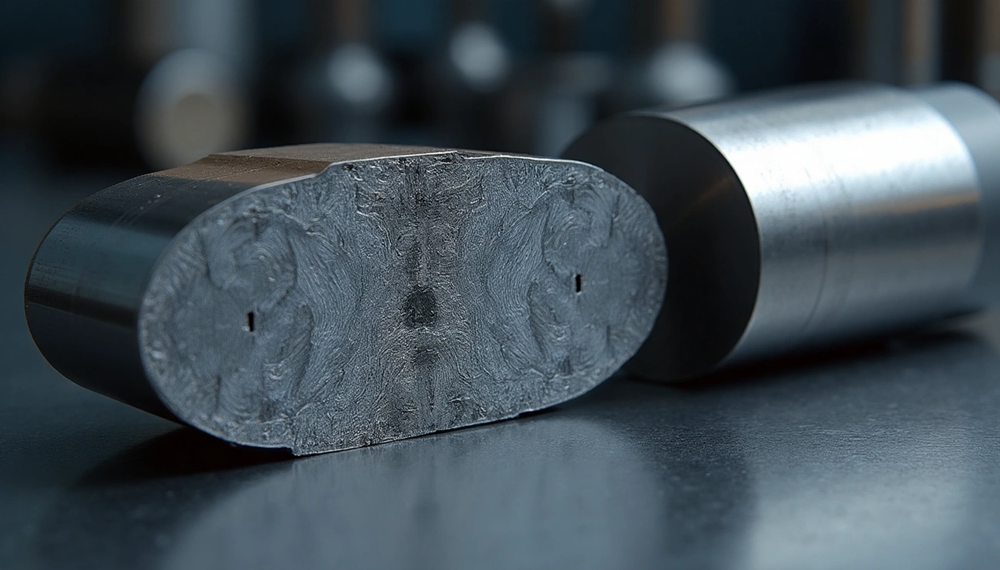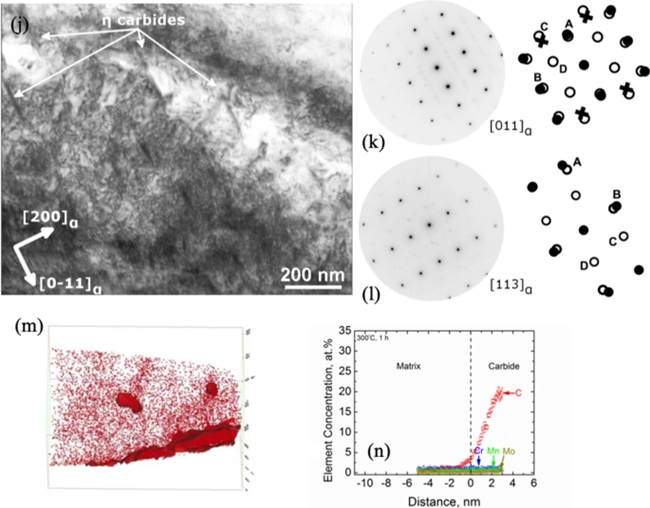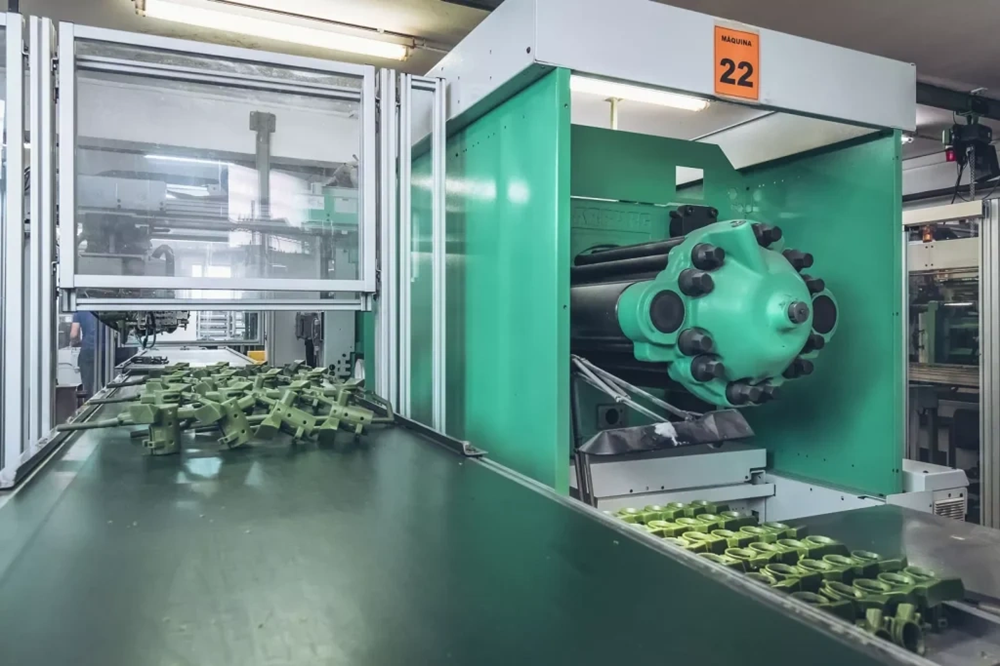
4340 steel properties blend strength and durability seamlessly in the metallurgical world. This nickel-chromium-molybdenum steel exhibits excellent hardenability and tensile strength, making it ideal for demanding applications. The steel delivers remarkable performance with yield strengths ranging from 740 to 1860 MPa and tensile strengths between 860 and 1980 MPa.
AISI 4340 is a heat-treatable, low-alloy steel that contains chromium, nickel, and molybdenum. It shows high toughness after heat treatment. The steel’s mechanical properties change substantially based on heat treatment. Its hardness ranges from 200 to 400 HV1, depending on the applied process. Modern manufacturing methods like additive manufacturing help 4340 steel reach yield strengths of 1240 to 1370 MPa and ultimate tensile strengths of 1360 to 1740 MPa.
Studies show that 4340 steel’s mechanical properties react consistently to tempering conditions. The steel’s strength, hardness, and strain-hardening exponent decrease as tempering temperature rises. This consistent behavior and its unique mix of ductility, toughness, creep resistance, and fatigue resistance make it better than most other steels. These qualities make it ideal for automotive parts, shafts, fasteners, and heavy machinery .
This piece examines MIM 4340 steel’s microstructure, mechanical properties, heat treatment factors, and manufacturing compatibility to give you detailed insights into this versatile material.
Microstructure and Phase Behavior of MIM 4340 Steel
MIM 4340 steel‘s microstructure shows complex phase behavior that shapes its mechanical properties. The Metal Injection Molded version develops unique microstructural features during processing, which sets it apart from regular wrought 4340.
Martensite, Bainite, and Austenite in Medium-Carbon Steels
The microstructure of MIM 4340 steel changes substantially with sintering temperature. Lower temperatures (1000-1100°C) create an even distribution of pearlite and austenite, with grain size growing at higher temperatures. The structure shows uneven distribution of bainite and pearlite when the sintering temperature reaches 1200°C, and bainite becomes the main phase. The material transforms almost completely to bainite at 1300°C. This behavior lines up with the Time-Temperature-Transformation (TTT) diagram for alloy 4140. When cooling happens from higher temperatures, the extended furnace cooling time lets bainite nucleate more effectively.
Effect of Carbon Content on Martensitic Transformation
The face-centered cubic lattice changes into a body-centered cubic or tetragonal lattice during martensitic transformation. This creates a much refined microstructure. A single prior austenite grain breaks down into martensite packets, blocks, sub-blocks, and laths during this sudden phase change. The transformation creates significant lattice strains and high dislocation densities due to volume changes. Carbon atoms from the austenite lattice structure are pushed into the ferrite lattice’s interstitial sites. This is a big deal as it means that solubility limits are exceeded, which results in a metastable microstructure.
Retained Austenite and Its Role in Embrittlement
Retained austenite plays a crucial role in tempered martensite embrittlement (TME) in MIM 4340 steel. Steels experience reduced toughness despite decreased hardness and strength within specific tempering regimes (300°C). TME happens because of several mechanisms:
- Retained austenite breaks down into interlath cementite and ferrite
- Cementite particles grow to critical sizes
- Retained austenite mechanically transforms to fresh martensite
Quick tempering (1-100s) reduces the TME toughness trough’s depth of 4340 steel by preventing retained austenite from breaking down. The steel shows better strength-toughness combinations compared to standard treatments when retained austenite is preserved during rapid tempering.
Mechanical Properties Under Different Tempering Conditions
Tempering conditions change 4340 steel’s mechanical properties dramatically. This creates opportunities to tailor the material precisely for specific applications. Companies like JH MIM use their deep metal injection molding expertise to understand the predictable patterns between heat treatment and material characteristics.
Yield Strength and Hardness vs. Tempering Temperature
4340 steel’s yield strength and hardness decrease in a systematic way as tempering temperature rises. The steel reaches a remarkable tensile strength of 1905 MPa (276 ksi) with a yield strength of 1530 MPa (222 ksi) at 204°C (400°F). The values drop by a lot as the tempering temperature rises to 649°C (1200°F). The effect shows up most clearly between 200°C and 350°C. During this range, hardness changes from about 760 HV to 450 HV in quenched samples. Tempering temperature affects mechanical properties more than tempering time.
Strain-Hardening Exponent and Ductility Trends
The strain-hardening exponent drops as the tempering temperature increases. This key parameter shows how well a material spreads deformation. Elongation values behave differently and increase from about 5% at lower temperatures to 10-13% at higher temperatures. Work hardening rate curves reveal that samples with more ferrite work harder. Material performance under load depends on this relationship between microstructure and strain behavior.
Tempered Martensite Embrittlement at 300°C
Tempered martensite embrittlement (TME) poses a serious problem for 4340 steel around 300°C. TME causes toughness to decrease even though hardness drops. Research shows TME develops from intergranular brittle fracture activation, where grain boundary carbides form. Fracture energy drops as tempering temperature rises between 200°C and 350°C. The main mechanisms involve interlath cementite precipitation from partial thermal decomposition of retained austenite. This leads to the mechanical transformation of destabilized austenite during loading . Experts suggest avoiding tempering 4340 steel between 250-450°C to prevent this harmful embrittlement effect.
Heat Treatment Parameters and Their Microstructural Impact

Heat treatment plays a key role in optimizing 4340 steel properties for metal injection molding. Manufacturers can fine-tune the microstructural development by controlling specific parameters that match performance needs.
Quenching at 850°C and Oil Cooling Effects
When 4340 steel undergoes austenitizing at 850-860°C and oil quenching, it creates a mostly martensitic structure that affects its mechanical behavior. This temperature range will give a complete austenite formation early while keeping grain growth in check. Oil quenching works better than water because it cools the steel at the right rate to form martensite and reduces distortion and cracks. The steel’s structure shows full martensitic features with many twins and prior austenite grains around 35 μm in size. All the same, quick cooling creates residual stresses that need tempering afterward.
Tempering Time vs. Temperature: 2h vs. 48h Holding
Temperature during tempering changes strength and hardness, while tempering time affects toughness and how stable the microstructure becomes. Studies comparing 2h, 24h, and 48h tempering at 300°C show:
- Strength and hardness stay similar, no matter how long the tempering lasts
- Ductility drops steadily as tempering time increases
- Impact toughness decreases a lot with longer tempering times
Looking at the fractures confirms this pattern. We see mostly ductile fractures with dimple patterns after 2-hour tempering, but mixed fractures with quasi-cleavage features appear after 48-hour treatments. This happens because of tempered martensite embrittlement when interlath carbide films form during long tempering periods.
Carbide Morphology: Plate vs. Spheroid Structures
Carbide shape makes a big difference in how 4340 steel performs mechanically. Plate-like carbides form early in tempering, about 30-50Å thick, and show up along dislocations every 100Å. Spheroidal carbides, on the other hand, develop when tempering happens at higher temperatures or runs longer. Steel with fewer large spheroidal carbides (>1μm) shows much better ballistic performance – V50 values jump up by more than 50% compared to regular treatments. When carbide spheroids dissolve back into the matrix, they boost the carbon in martensite, which pushes hardness up from HRC 53.5-54 to HRC 56.
Additive and MIM Manufacturing Compatibility of 4340 Steel

Advanced manufacturing methods have created new possibilities for 4340 steel. This versatile alloy now suits complex components that need exceptional mechanical properties. Metal Injection Molding (MIM) and Additive Manufacturing (AM) processes are a great way to get unique advantages for this high-strength, low-alloy steel.
Selective Laser Melting (SLM) and AM Processability
AISI 4340 steel works exceptionally well with additive manufacturing processes, particularly Laser Powder Bed Fusion (L-PBF). This manufacturing method combines metal powder layer by layer through laser melting and solidification. Recent studies show that 4340 steel naturally suits AM processing without the need for expensive post-fabrication treatments. The medium carbon content and low alloying element concentration help AM processing create uniform, refined microstructures with minimal elemental segregation. The powder feedstock provides proper packing and flowability during the recoating process. Gas-atomized 4340 steel with particle size distribution of 1% +53 microns and 10% <22 microns works best. Precise control of processing parameters creates a shift from upper bainite to lower bainite dominance. This allows customized mechanical properties for specific applications.
Achieving >99.9% Densification in AM 4340 Steel
Creating near-perfect densification in AM 4340 steel needs precise parameter optimization. Studies have found the perfect parameter set: laser power = 200 W, scan speed = 600 mm/s, hatch spacing = 0.12 mm, and slice thickness = 0.03 mm. This corresponds to a volumetric energy density (VED) of 92.6 J/mm³. The configuration produces a relative density of 99.9%. Relative densities above 99.8% can be achieved with volumetric energy densities between 93 to 162 J/mm³. These optimized parameters shape the microstructure too. High VED samples typically contain circular keyhole pores. This differs from irregular lack-of-fusion flaws found in samples made with lower energy density.
Comparison of AM vs. MIM Mechanical Properties
AM and MIM processing routes create 4340 steel with different mechanical profiles. AM-fabricated 4340 steel shows impressive yield strengths from 1240 to 1370 MPa. Ultimate tensile strengths range from 1360 to 1740 MPa, with elongation between 7% to 14%. These properties match wrought steel counterparts and surpass many other AM steels. MIM 4340 steel in heat-treated condition shows yield strength of 1400 MPa and ultimate tensile strength of 1600 MPa. However, it has lower elongation at only 2%. JH MIM brings nearly 20 years of experience in the Metal Injection Molding industry. Their factories span more than 18000 square meters, equipped with world-class equipment and 150 skilled workers. As China’s leading Metal Injection Molding Manufacturer, they deliver precision-engineered MIM 4340 components with consistent batches and excellent dimensional control.
Conclusion
AISI 4340 steel is a remarkable engineering material that works well in demanding applications. We have seen how controlled heat treatment processes dramatically change their microstructure and influence mechanical performance. The material’s final properties depend on the complex interplay between martensite, bainite, and austenite phases, while tempering parameters give precise control over strength, hardness, and ductility.
Manufacturers need to think about tempering temperature and duration carefully to avoid the critical embrittlement zone around 300°C. The carbide morphology—whether plate-like or spheroidal—is one of the most important factors that determine performance characteristics for specific applications. On top of that, modern manufacturing methods like Selective Laser Melting and Metal Injection Molding have opened new possibilities for this versatile alloy.
The material’s adaptability to advanced processing techniques shows in its ability to reach near-perfect densification (>99.9%) through optimized AM parameters. The predictable way 4340 steel responds to various thermal treatments lets engineers fine-tune its properties for automotive components, shafts, fasteners, and heavy machinery applications.
JH MIM has spent nearly 20 years in the Metal Injection Molding industry making precision-engineered MIM 4340 components. The company’s factories span more than 18000 square meters and house world-class equipment operated by 150 skilled workers. As China’s leading Metal Injection Molding Manufacturer, JH MIM delivers high-quality products to customers worldwide. This blend of material excellence and manufacturing expertise makes 4340 steel the life-blood of critical applications where strength, toughness, and durability must be perfectly balanced.
Key Takeaways
MIM 4340 steel offers exceptional versatility through precise control of microstructure and mechanical properties via heat treatment parameters, making it ideal for demanding engineering applications.
• Tempering temperature controls strength: Higher tempering temperatures systematically reduce yield strength and hardness while improving ductility and elongation in 4340 steel.
• Avoid 300°C tempering zone: Tempered martensite embrittlement occurs around 300°C, causing reduced toughness despite lower hardness—avoid 250-450°C range.
• Advanced manufacturing compatibility: Both AM and MIM processes achieve >99.9% densification with optimized parameters, producing properties rivaling wrought steel.
• Microstructure determines performance: Carbide morphology (plate vs. spheroidal) and phase distribution (martensite, bainite, austenite) directly influence mechanical behavior.
• Predictable property tailoring: 4340 steel responds predictably to heat treatment, enabling precise customization for automotive, aerospace, and heavy machinery applications.
The combination of controllable microstructure, excellent hardenability, and compatibility with modern manufacturing methods positions MIM 4340 steel as a premier choice for critical components requiring optimal strength-to-weight ratios and dimensional precision.
FAQs
Q1. What are the key mechanical properties of MIM 4340 steel? MIM 4340 steel exhibits high strength and toughness. It typically has yield strengths ranging from 740-1860 MPa and tensile strengths between 860-1980 MPa. The exact properties can be tailored through heat treatment, with hardness ranging from 200 to 400 HV1, depending on the specific process applied.
Q2. How does tempering temperature affect the properties of 4340 steel? As tempering temperature increases, the yield strength and hardness of 4340 steel decrease systematically. However, ductility and elongation tend to improve at higher tempering temperatures. It’s crucial to avoid tempering in the 250-450°C range to prevent tempered martensite embrittlement.
Q3. What manufacturing methods are compatible with 4340 steel? 4340 steel is highly compatible with both Metal Injection Molding (MIM) and Additive Manufacturing (AM) processes, particularly Selective Laser Melting (SLM). These advanced manufacturing methods can achieve near-perfect densification (>99.9%) with optimized parameters, producing parts with properties rivaling those of wrought steel.
Q4. How does the microstructure of 4340 steel influence its performance? The microstructure of 4340 steel, including the distribution of martensite, bainite, and austenite phases, as well as carbide morphology (plate-like or spheroidal), directly impacts its mechanical properties. Controlling these microstructural features through heat treatment allows for precise tailoring of strength, toughness, and durability for specific applications.
Q5. What are some common applications for MIM 4340 steel? Due to its excellent combination of strength, toughness, and fatigue resistance, MIM 4340 steel is widely used in automotive components, shafts, fasteners, and heavy machinery. Its predictable response to heat treatment makes it particularly valuable for applications requiring precise property customization and high performance under demanding conditions.
